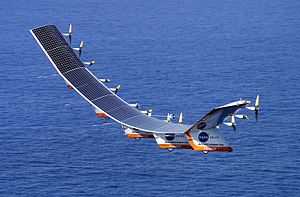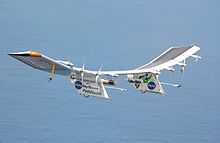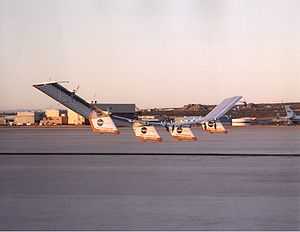Atmospheric satellite

An atmospheric satellite (US usage, abbreviated atmosat) or pseudo-satellite (British usage) is an unmanned aerial vehicle (UAV) that operates in the atmosphere at high altitudes for extended periods of time. Atmosats are generally powered by solar panel arrays and rechargeable batteries or fuel cells, though a balloon-based system is also under development. Atmospheric satellites are distinguished from low earth orbit satellites, which orbit above the atmosphere.
Development history
The initial goals under the NASA's Environmental Research Aircraft and Sensor Technology (ERAST) project were to demonstrate sustained flight at an altitude near 100,000 feet and flying non-stop for at least 24 hours, including at least 14 hours above 50,000 feet.[1] The early development path of atmospheric satellites included the NASA Pathfinder (exceeding 50,000 feet in 1995), the Pathfinder Plus (80,000 feet in 1998), and the NASA Centurion which was modified into a prototype configuration for the NASA Helios (96,000 feet in 2001).[1] An Airbus/Qinetiq Zephyr clocked up a 14-day flight in the summer of 2010 and in 2014 a Zephyr 7 stayed up for 11 days in the short days of winter whilst carrying a small payload for the British Ministry of Defence.[2] In 2014, the development goals of Titan Aerospace, purchased by Google,[3] included operation at altitudes exceeding 60,000 feet for as long as five years.[4]
Vehicle design and operation, and enabling technology
An atmospheric satellite may initially ascend at night under battery power, and reach altitude soon after dawn to allow solar panels to take advantage of a full day's sunlight.[4] To enable nighttime operation and ensure endurance through consecutive 24-hour day/night cycles, in daylight hours solar panels charge batteries[5] or fuel cells[1] which subsequently power the vehicle during hours of darkness.
A desired operating altitude is in the tropopause—at approximately 65,000 feet—where winds are generally less than 5 knots and clouds do not block sunlight.[5] It is desirable in the United States to operate above 60,000 feet, above which the Federal Aviation Administration does not regulate the airspace.[5]
Competing technologies
Atmospheric satellites are thought to be able to perform duties more economically and with more versatility than low earth orbit satellites,[4] which are less well suited for border security, maritime traffic monitoring, anti-piracy operations, disaster response, and agricultural observation.[5]
The NASA and Titan Aerospace designs use propeller-driven aircraft, in contrast to Google's Project Loon which envisions using high-altitude balloons.[4][6]
Applications
Applications include atmospheric observation, weather monitoring, communications relay, oceanographic research, and earth imaging[5] as well as disaster recovery and Internet communication, with Facebook reportedly envisioning providing Internet access to the African continent with a fleet of 11,000 vehicles.[4]
References
- ↑ 1.0 1.1 1.2 "NASA Armstrong Fact Sheet: Helios Prototype". NASA. Indicated as updated on February 28, 2014. Archived from the original on March 9, 2014. Check date values in:
|date=(help) - ↑ Tovey, Alan (31 August 2014). "Fly 11 days non-stop? Now that's long-haul". Daily Telegraph.
- ↑ "Google Buys High-Altitude Drone Maker". The New York Times. April 14, 2014.
- ↑ 4.0 4.1 4.2 4.3 4.4 Perez, Sarah; Constine, Josh (March 4, 2014). "Facebook In Talks To Acquire Drone Maker Titan Aerospace". TechCrunch. Archived from the original on March 4, 2014.
- ↑ 5.0 5.1 5.2 5.3 5.4 Dillow, Clay (August 23, 2013). "The drone that may never have to land". Fortune (CNN). Archived from the original on March 9, 2014.
- ↑ Google Buys Solar-Powered Drones to Expand Internet Access, Accessed April 22, 2014
See also
- Geostationary satellite
- Geostationary balloon satellite


